|
FAQs About Soft/Shell Rot, Conditions In
Turtles 14
Related Articles:
Shell Rot in Turtles,
Treating Common Illnesses of
the Red Ear Slider (& other Emydid Turtles) by Darrel
Barton,
The
Care and Keeping of the Red Eared Slider,
Trachemys scripta
elegans by Darrel Barton,
Red Ear Sliders,
Turtles,
Amphibians, Red Eared Slider Care,
Related FAQs:
Shell Rot and Conditions 1,
Shell Rot 2,
Shell Rot 3,
Shell Rot 4,
Shell Conditions 5,
Shell Conditions 6,
Shell Conditions 7,
Shell Conditions 8,
Shell Conditions 9,
Shell Conditions 11,
Shell Conditions 12,
Shell Conditions 13,
Shell Conditions 15,
Shell Conditions 16,
Shell Conditions 17,
&
Turtles,
Turtles 2,
Turtle Identification,
Turtle Behavior,
Turtle Compatibility,
Turtle Selection,
Turtle Systems,
Turtle Feeding,
Turtle Disease,
Turtle Disease 2,
Turtle Disease 3,
Turtle Reproduction,
Amphibians,
Other Reptiles,
|

|
|
Shell problem 8/22/12
Hello WWM Crew,
<Hi Jonathan; Sue here with you.>
I have a turtle with white spot on the top of the shell. It looks like
it also has some green in it so I'm thinking that it might be some king
of fungus. The turtle is about a year old and my girlfriend was the
original owner and she gave it to me like that. I thought it was
something that normal for that species its from Nicaragua and I have 2
red eared sliders. I did some research about it and this got me thinking
that it wasn't normal. I'm new to turtles and I don't know what to do
about it. I've also attached some pictures.
<It's very difficult to confirm fungus from a picture alone. From the
close-up photo, it looks like your turtle is shedding its scutes. When
this happens, water can get trapped between the old and new layers which
can sometimes lead to fungus developing. One way to try to confirm
if it’s a fungus is to see if it rubs off with a cotton swab. If it does
then it probably is. In either case it doesn’t hurt to assume that it is
and treat it as such. Here's a link with instructions for treating (see
the section marked, “Fungal Infections”):
http://www.wetwebmedia.com/FWSubWebIndex/treating%20RES%20Dis%20DarrelB.htm
>
Please help.
Thank You
<You’re welcome, Jonathan. I’m also giving you a link to our basic care
article:
http://www.wetwebmedia.com/FWSubWebIndex/RESCareBarton.htm >
<Almost all problems with turtles can be traced back to diet or
environmental issues. In the case of fungus, you want to make sure that
you’re providing your turtle with an adequately sized warm and dry spot
(88-90 degree F) that allows him to get out of the water each day and
completely dry off. Besides a heat lamp placed directly above the
basking area, you should also have a UVB strip light above the basking
spot. Turtles need BOTH types of lighting. Try to direct the lighting
away from the water as this can make the water too warm (water should be
on the cool side, only in the 68-70 degree F range) and can encourage
algae growth. Also make sure you keep the water and tank nice and
clean.>
<Try these suggestions out and see if they help. Good luck! ~ Sue>
Jonathan
|
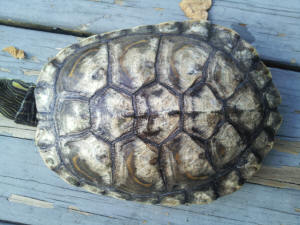 |
|
Re: Shell problem 8/27/12
You are right, it seems to between the layers of the shell. How
can I take it off? Should I scrape it with something?
<If in fact it is a fungus and is not on the surface but instead between
layers of shell, then I wouldn’t scrape away at the shell to try to get
at it. You want the shell to shed naturally and you don’t want to
accidentally remove one too many layers.>
<Fungus loves moisture, so what I’d suggest instead is to dry dock him
for a while and limit his access to water each day. Here’s a link
with instructions for how to do that-
http://www.wetwebmedia.com/FWSubWebIndex/treating%20RES%20Dis%20DarrelB.htm
>
<Refer to the section called, “Isolation and Dry Dock”. Of note in these
instructions is to make sure he has access to not only a heat source but
also UVB while you’re dry docking him; and also the instructions for how
to provide him access to some water each day.>
<Then while he’s out, make whatever modifications necessary to his
environment to prevent the fungus from reoccurring. For example,
make sure that he’s able to – and IS – getting out of the water for
several hours each day to bask under heat and UVB. If he hasn’t
been doing that up to this point, you need to determine why -- i.e.
water not cool enough to motivate him to get out to bask; basking area
not warm enough for him or is too small for him to get his whole body
entirely out of the water; no UVB light along with the heat bulb, water
not getting changed frequently enough, etc. – you get the idea!
Though shedding can often “set the stage” for a fungus to develop, it’s
the environmental factors that most often sway it in one direction or
the other. So whatever extent you can fix the environmental
factors will make him much less susceptible to fungus in the future.>
<Hope this helps! ~ Sue>
<Jonathan - one more thing besides my recommendations below is to also
try applying some antifungal cream to his shell using a toothbrush each
day. The link I gave you talks about this in more detail - see the
section called "Fungal Infections". >
|
Turtle Shell turned white 8/5/12
Hello,
<Hiya - Darrel here>
Our yellow bellied slider is approximately two years old and female.
About a month ago her shell turned almost completely white (like it's
bleached).
<Strange>
Other than that, she is acting completely normal and eats well (mostly
pellets with occasional fish and greens). This seemed to happen
not long after we had to separate her from another yellow bellied slider
because she was eating the other ones legs (that turtle is amazingly
doing fantastic - thriving and eating). Is this something I should
be worried about and is there something I can and/or should do?
<This is an uncommon occurrence, Robin. White PATCHES on the shell
can be one of three things: Fungus, Bacteria or mineral deposits.
A complete loss of color indicates something else, but WHAT it indicates
… that's tough. The worst case is that the living material under
the scutes has simply died … but I've never heard or seen of that - EVER
- happening uniformly and suddenly.>
<You have several simple options. 1- Try to rub or scrape a small
portion off. See if it comes off, see if what comes off smells and
see what the color is underneath. 2 - Try a small amount of
vinegar on a Q-tip and rub a spot, see the reaction. Even a small
amount (2-3 drops) of chlorine bleach on a Q-tip and then rub an out
scute on the side and see what, if anything, changes. 3 - A trip
to the Vet for a quick exam. The problem here, Robin, is that
while your explanation is very clear, this is one that has to be
physically seen to render an opinion>
Thank you in advance for any help you can provide.
<One last thought - look on the internet for a Turtle & Tortoise Club in
your area. Maybe you can find an experienced "old hand" that could
take a look in person>
Females shell 7/29/12
Warmest greetings and thank you for your time, my 5year old +,female res
Mayham has a shell that the part on top near her tail, flares up
dramatically, instead of down as she has grown, was just wondering if
its normal. Gina.
<No, it isn't normal, and normally means one of two things: poor diet
(specifically, lack of calcium) and lack of UV-B (either a UV-B lamp
over the basking area or several hours of direct -- not through glass!
-- sunlight). Review, and act accordingly. Cheers, Neale.>
Re: Females shell 7/29/12
Thank you for your time and response
God bless
<Happy to help! Neale.>
|
My baby sliders possible shell rot 7/21/12
Hello,
I've included several pictures of my two female yellow belly sliders….I
have not noticed any change in there activity. I clean there tank every
2 days. They have a diet of turtle pellets, lettuce and carrots. i also
use a water treatment for the tap water.
I have noticed there bellies have been darkening lately. and one of them
came to me with a wart like bump on her shell but it has improved
greatly and fresh new shell is now visible.
<Good.>
The darkening on the bottom of the shell is what worries me, I have
taken the following steps since i noticed the bottom of the shells.
<Some change in the colour of the shell is normal; as the animals age,
their colours will become duller, muddier. So long as the shell smells
clean and feels firm, don't worry too much. Use a fingernail to scrape
at the suspect area of the shell; healthy shell will resist scraping and
feel tough, like horn; soft shell will flake or come away as powder, and
there's usually a distinct fungus odour as well.>
1. I have raised the wattage of the lamp to increase the heat, but i
also leave a shaded area for them.
<Good. Heat isn't the only thing though; you must provide UV-B light as
well. You can buy combination lamps. You don't want an ordinary UV light
though, or UV-A, but specifically UV-B.>
2. I leave them in a clean dry tank for at least 2-3 hrs. depending on
the weather
<Not really necessary, but if they don't mind it, then go ahead and do
this. But otherwise, if the air under the heat lamp is warm, they'll dry
off naturally.>
3. I never feed them in there living tank, i use a separate feeding
tank.
<A good idea.>
4. I never fill the living tank with water level above the rock level to
leave room for basking.
<Also good.>
I admit to having a tank which is too small for their growth, but we are
working on upgrading their living quarters shortly.
<Good.>
what can i do to reverse the affects if any and any tips on what needs
to be corrected in my turtle keeping?
<Do start by reading here:
http://www.wetwebmedia.com/fwsubwebindex/RESCareBarton.htm
http://www.wetwebmedia.com/fwsubwebindex/turtshellrot.htm
Adequate calcium in their diet plus a UV-B light source are the two
keys. Vitamin supplements help with the former, and a UV-B lamp supplies
the latter. Cheers, Neale.>
|
.jpg)
.jpg) |
|
Re: My baby sliders possible shell rot 7/22/12
Thank you so much for your prompt response.....I feel a lot better now,
I checked but no signs of soft or smelly shells. I will keep an eye on
them....Thanks again.
<Glad to help. Prevention is better than cure, so be sure to follow the
tips on diet and UV-B. Cheers, Neale.>
|
|
Shell help! 7/1/12
Hi guys, I'm in need of your help and frankly am worried.
My brother bought a yellow bellied slider about a month ago. I took
interest in the turtle about three days ago and saw that he had no
suitable condition for the turtle to live comfortably. I took matters in
to my own hands and buying him a 10 gallon tank with lights
<UVA and B? What re diet?>
and basking area.
<Okay>
What I want to know is, if my turtle has developed some type of fungus
or maybe have shell rot? He is what I imagine a month and a half to 2
months old. He has these white marks where the shell and scutes meet.
I thought it was shedding but he smelled a bit ugly and the
spots/marks are softish.
<Not good>
He, for a month has not been in any type of light and has been eating
pellets, shrimp, and krill. Also I try to clean his bowl/pond every
other day. I'm really concerned, and I have gotten quite attached to
Jenkins (my turtles name).
He eats normally and very aggressively, also he does not like to bask
anywhere dry. (I assume because there is no difference in temperature.)
I would really appreciate any and all feed back! Any common household
medicine i could use or maybe a certain diet.
Thanks from Mike and Jenkins!
<Please read here:
http://www.wetwebmedia.com/FWSubWebIndex/treating%20RES%20Dis%20DarrelB.htm
and
http://www.wetwebmedia.com/FWSubWebIndex/turtshellrot.htm
and the linked files above. Bob Fenner>
|
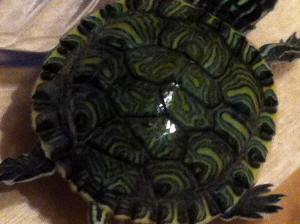
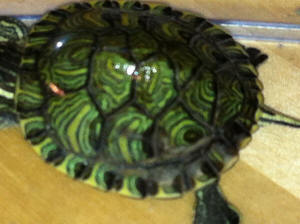 |
|
Red Eared Slider; shell and system/care
6/28/12
Hi,
<Hi Lauryn, Sue here with you.>
I have a RES turtle maybe 7 months old. Its name is Luna. Luna lives in
a 10 gallon tank and is about 1 inch long. I have no clue if it is a
girl or boy yet.
<You won’t know for sure until its top shell (carapace) reaches around 4
inches in length.>
I was writing you because around the crevices of its shell it
has shiny grey lines. I was thinking it might have been shedding its
scutes but it has been like that for about a month.
<That happens when they’re growing. As long as you don’t feel any soft
spots it’s fine.>
Also when I bought Luna it had a spot on its shell, kinda white but
greyish too. Luna still has the spot and it has grown larger. You can
see the spot in the picture the spot's on the left side of the shell.
Also Luna has some white spots going down the center of the shell and on
the bottom of the shell it's kinda hazy.
<Unfortunately nothing discernible came through on the photos; the shell
looked fine to me. Is there any odor to the shell? >
I clean Luna's tank out fully every week
<Because it’s a smaller tank, I’d suggest more frequent water changes as
there isn’t as much water is a small tank to dilute the food and waste.>
and have a filter, basking lamp, uva light,
<UVA is not adequate. You MUST have a UVB; this is very
important.>
and a basking rock.
<Good; just make sure she has no problem getting up on it and can
completely dry herself off when basking on it.>
I give it pelleted food,
<That’s fine, just make sure you only feed her the pellets every other
day and only as much as she’ll eat in 5 minutes or so, no more.
Then net up any uneaten food after that; this will also help the water
stay cleaner longer. You should also net up any waste as soon as you see
it as well in between the water changes.>
occasionally meal worms,
<We recommend earthworms instead and only one or two every month or so.>
and a calcium block for turtles. When I clean out the tank I dump out
all the water, rinse off the rocks and the plant and the basking rock,
also i rinse out the tank and the filter cartridge. I use a fish tank
filter. I am getting a Repti-filter very soon.
<Unfortunately even the filters made for turtles are often not enough
(in fact many articles go so far as to recommend you DON’T use turtle
filters for turtles!) Whatever filter you do get, just make sure
it’s the best mechanical filter you can afford, and one that’s at least
(and preferably more than) 3 times greater than what it’s rated for. And
even with that you’ll still need regular partial water changes.>
I also put Repti-safe in the water after I clean it.
<No need for this at all; plain tap water is fine. The tiny bit of
chlorine that is in tap water will actually help a bit with the water
quality.>
Luna lives alone. A couple days ago I looked in the tank and it had
skin/slime looking stuff coming off of it. It's gone now though. At
night when the basking lamp is off, I usually turn on the heater.
<Do you mean a water heater? There’s no need for either at night,
and there shouldn’t be any heater in the water at all day or night.
You want the water to be on the cooler side; around 68-70 degrees F,
which is room temperature for most people.>
I tried to clean Luna's shell with a soft bristled tooth brush, but it
didn't really work. What's wrong with Luna? What should I do?
<Lauryn, I really couldn’t see anything on the photos you sent. However,
from your description of white spots on the shell, slimy stuff on her
skin and the habitat, it’s very possible that she (or he!) may be
developing some surface fungus on her skin and shell. So first,
here’s a link that tells what you can do to treat it (and even if it’s
not fungus, won’t hurt to treat as if it is):
http://www.wetwebmedia.com/FWSubWebIndex/treating%20RES%20Dis%20DarrelB.htm
>
<And next, make the changes I mentioned above to her habitat. The most
important ones for her shell are to make sure that she basks for several
hours a day, that she can get completely out of the water to dry off,
that she has a UVB not just a UVA light above her basking area (UVB
lights have both UVA and UVB), and that the temperature above her
basking area is around 88-90 degrees F. Also remove the water heater if
have one, and do more frequent water changes. You might also try feeding
her in a separate enclosure (basically the less organic material in the
tank the better). >
Thank you so much for all your help!!
<You’re welcome, I hope this did help! Try these things out and write us
back if any more questions or concerns pop up. I’m also going to give
you this link to our basic care guide to read over and make sure you
have everything covered:
http://www.wetwebmedia.com/FWSubWebIndex/RESCareBarton.htm >
|
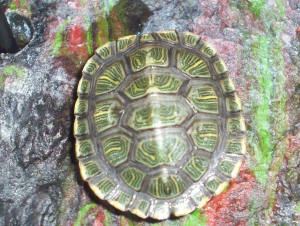
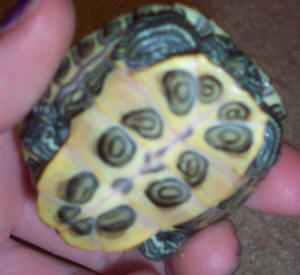 |
|
unknown spot on turtle shell 6/23/12
HI,
<Hiya - Darrel here>
Could you please diagnose this fungus looking spot on the turtle's
shell?
<I can try>
He is a Mississippi Mud turtle.
<He certainly is!>
See image attached.
<OK>
Thanks!
<Yer welcome!>
<From way over here, without being told if the spot is hard, soft,
smelly or odorless - I can only guess the same as you - that it's a
fungus. Test this by taking a wooden toothpick (or something
similar) and scrap the area. A surface fungus will come off
on the toothpick and when you put it to your nose, it will smell.
If it doesn't scrape, then you have two possibilities
1- That it's a fungus under the carapace. If that's the
case, you'll just "see" that there's a clear film over the area and
you're not touching the material itself.
OR
2- it's not fungal at all and could be a healing wound. When
the carapace material itself dies, the area becomes white and hard and
bone-like (because, oddly, it's bone) and that is just the way the
turtle lives.>
<If it's fungal, treat as in here:
http://www.wetwebmedia.com/FWSubWebIndex/treating%20RES%20Dis%20DarrelB.htm
>
<If it's a scar … make up a really cool reason how it got it … like he
got into a knife fight in a biker bar - and brag about it>
|
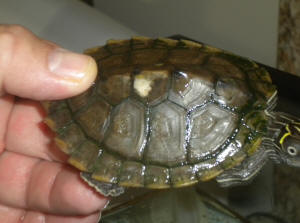 |
|
Re: unknown spot on turtle shell 6/27/12
Hi Darrel!
<Hiya>
What a great reply...i appreciate the entertainment :)
I was actually sending this email on behalf of my boss but apparently he got
everything straightened out over the weekend and the turtle is
recovering well.
<Yanno .. if we had a dime for every time someone wrote in asking for advice
not for THEM but for "their boss" we'd have ... ah ... well ... a dime!>
It's amazing you figured out that he was a badass biker turtle just by
looking at his spot!
Have a nice week,
<You too!>
Nina
|
Rot or Shedding? 6/3/12
Hello, Marjorie here!
<Hi, Marjorie! Sue here with you.>
I have a question in regards to a Yellow-Belly Slider
that I received as a gift six months ago. She had not shed any
scutes during the duration of the past six months, but I've noticed that
she has begun to shed the ones on her plastron.
<They don’t always shed evenly at the same time. >
Since shedding those, I've noticed that a couple of the scutes on her
carapace are beginning to lighten. It is not severe, but it IS
noticeable. Could she possibly have shell rot?
<Unless you’ve noticed the shell has some soft spots, foul odor, or the
actual plates coming off and exposing tissue below, it’s unlikely your
turtle has shell rot. The new shell growth will often look a bit lighter
in color (before the old shell comes off it often gets a darker color to
it). As long as the new shell you’re seeing is hard and looks healthy,
you shouldn’t worry.>
As far as my setup goes, I have her in a 20-gallon tank, with a floating
dock and UVB/UVA bulb. The water stays around 75 degrees F, and
her basking area is around 90.
<This all sounds perfect so far!>
I have no filter, but am going to get one soon, and the tank is scrubbed
and filled with fresh water every other day; it also is never filled
more than half full.
<Sounds like you’re taking good care of her!>
As far as the baby herself, she has an insatiable appetite, and eats
ReptoMin Floating Mini-Sticks,
<Very good. Just watch that you don’t give in to her 'insatiable
appetite'! Overfeeding is the most common mistake people make with
turtles. You didn’t mention her size but if her carapace is under 4” in
length, just feed her every other day - no more – and only as much
as she can eat in 5 minutes or so – no more!>
and the occasional threat of a mini-krill or baby shrimp.
<Would eliminate both; they have no nutritional value.>
She also gets an occasional mealworm (cut in half to allow easier
digestion).
<Good except I’d substitute earthworms for mealworms; they’re a more
nutritious snack.>
She has had no past health problems, and is very energetic when she
isn't basking.
<All good signs!>
Unfortunately, I don't have any pictures to offer, but practical advice
would be helpful.
<Marjorie, it sounds like you’ve done your research and have all the
basics down. Just make sure not to over-feed her. I’ll also give you
this link to our basic care article to make sure you have all the bases
covered:
http://www.wetwebmedia.com/FWSubWebIndex/RESCareBarton.htm >
Thank you so much for taking the time to read my email, and have a nice
day!
<You’re welcome, Marjorie; hope it helped. You’re doing a great job so
far!>
|
Help - two (2) RES living in
Malaysia. Hlth. 4/14/12
Dear WWM Crew,
<Hiya - Darrel here>
I live in Malaysia with limited vet treating exotic animals. I
have been researching online and still could not confirm the
problem of my Red Eared Slider turtles. I love and am very proud
of them and want them to live as long as possible.
<We and they thank you for your caring>
Just a quick summary of what happened.
What made me extra concerned about their current condition is the
death of one of my RES (8-inch) a few weeks ago at the
'vet'.
<Well, that will do it>
I do not trust the vet anymore because they did not even realized
my RES was dead until I went to pick it up the next day.
They put my RES into a big tub resided by 30 gold fishes.
<Sick reptiles should never be kept in water. They
are best off in a warm dry place>
My RES had a 'puffy/ saggy' neck. I didn't
bother at first but then, I saw an ulcer growing on the area and
later on, the ulcer turned from white to brown and then burst, no
longer puffy but saggy skin. The process was not sudden, its neck
was puffed since many years ago.
<But it WAS an indication that something was wrong>
It was still eating and running on the last day I had him in the
tub. I suspected it drowned and died. When in the goldfish tub,
it was struggling to float and I didn't know it couldn't
swim.
<I'm completely confused. The Vet put him in a tub
with no basking area when in his care? Here it sounds like
YOU kept him that way>
Its dead body was like a statue, it stood steadily at the bottom
of the tub, eyes turned blue, all limbs and head were out from
the shell.
<Debilitated from years of improper care and too weak to
struggle any longer>
Alrighty, now in the attached picture, you will see arrows
pointing at problem areas of my living RES which confused me. I
do not know if it is water retention/ edema or obesity. Both
turtles have the same problem at both their thigh areas, the
female (on top) being more serious.
<I would suggest that you know if you're feeding them more
than you should: They should have a vegetable-based diet
(such as Koi Pellets) and all they can eat in 5 minutes, 3-4
times a week. No more>
I have been keeping the female RES since I was seven (7) years
old and I was totally clueless about how to care for the turtles.
That probably explains the pyramiding.
<Actually their shells seem flattened. I'd make sure
they're getting enough calcium>
The female RES however survives and is now twenty-two (22) years
old, 8-inch, been laying eggs every year the latest being Jan-12
(13 eggs) and Feb-12 (5 eggs). She loves eating and if I feed her
only a little food, she will keep checking the butt of the male
RES, waiting to eat poo.
<Yes … not very appetizing dinner conversation,
however>
They both live outdoor in a big blue tub under the roof without
any lamp or filter. Natural sunlight everyday with average
temperature of 32-34 degree Celsius all year round. I change
their water everyday.
<My only concern is that the water will tend to get too warm
under those conditions. If possible, find a way to shade
the water so only the basking area gets sunshine>
Water height is around 3-4 inch.
<That will heat up very quickly>
I used to feed them only turtle pellets, but have recently cut
down pellets and introduced vege and fruits. I feed them
everyday. I noticed that they bask everyday.
<Good>
Would you be able to confirm their problem? Shall I
add more water into their tub or dry dock them for a period? Can
I feed more to the female RES because she might be pregnant and
need to eat more?
<Try giving her (actually both of them) a calcium
supplement.>
And also, I believe the bottom turtle is experiencing shell rot.
The arrows pointed area has turned whitish. They bask everyday
and I have been keeping the water clean now so I am hoping it
will heal naturally. Is that possible?
<It's possible, but I'd dry-dock him for a month or so
just to be sure. As soon as his carapace REALLY dries out,
you'll be able to spot and treat the fungus if it's
there. You would be shock at the number of times a case of
shell rot turns out to be nothing more than water spots from
minerals in the water>
It would be so much appreciated to get a reply from you. I let
them out for a walk, bath and feed them everyday and my love for
them is no lesser than a mother's love.
Thank you.
Regards
Yann
<I hope we helped, Yann:
http://www.wetwebmedia.com/FWSubWebIndex/RESCareBarton.htm
http://www.wetwebmedia.com/FWSubWebIndex/treating%20RES%20Dis%20DarrelB.htm
>
|
.jpg) |
|
Painted turtle shell issues? Neale's try
2/29/12
I have a young painted turtle who has recently been developing
some shell issues, can you maybe help tell me what they
are? In one of the pictures it shows a black spot with
white in the middle on my turtles underside, the back has been
there for a while but recently the white started coming and it
looks like some sort of disease or infection. Also my
turtle's shell has began separating as well as turning
upwards, although I know that the turning up of the shell is from
a bad diet and eating too much but I'm not sure if the
splitting of the shell has anything to do with it?
Thank you,
Veronica C
<Hello Veronica. The key thing here is whether the shell
smells normal or musty. If there's any odour like mould or
similar, then Shell Rot may be an issue, and you'll need to
treat. If in doubt, consult a vet; but in the meantime, do read
here:
http://www.wetwebmedia.com/fwsubwebindex/turtshellrot.htm
Take some time checking the "holy trinity" of things
that cause problems with turtle shells: diet (need a source of
calcium); basking lamp (needs UV-B); and water quality (regular
water changes and a filter essential).
Cheers, Neale.>
Painted turtle shell issues? Darrel's go
3/1/12
Dear Crew,
<Hiya - Darrel here>
I have a young painted turtle that has recently been developing
some shell issues, can you maybe help tell me what they
are? In one of the pictures it shows a black spot with
white in the middle on my turtle's underside, the back has
been there for a while but recently the white started coming and
it looks like some sort of disease or infection.
<That picture is certainly large, but the image isn't
actually very clear. It would help if you could send
another. In the mean time, a white from an infection will
appear very clearly to be ON TOP of whatever coloration is
present. You can usually get a toothpick and scrape a
tiny bit and the white will come OFF … or at least you'll
see the background coloration below it. Further rubbing
with a cotton swab and some vinegar will usually result in a
removal of at least the outer layer - if it's fungus.>
<It's easy enough to treat him for a fungal infection even
if it's just a normal shift in color: After he's
been dry for a few days, the difference in texture between an
infection and normal coloration becomes fairly
pronounced.>
<read:
http://www.wetwebmedia.com/FWSubWebIndex/treating%20RES%20Dis%20DarrelB.htm
>
Also my turtle's shell has began separating as well as
turning upwards, although I know that the turning up of the shell
is from a bad diet and eating too much but I'm not sure if
the splitting of the shell has anything to do with it?
<The terms you use are a bit vague. As they grow the
outer edges of the scutes (the pieces that make up the top of the
shell) do curl up a bit. As each scute gets ready to
separate, the edges will separate first. The key here
is that you can see the scute become milky-clear … like a
fingernail … as it separates from the fresh scute below>
He has a heat lamp and a light that are left on most of the time
also.
<Some clearer pictures would be most helpful>
Thank you,
<Yer welcome!>
|
|

|
|
|

